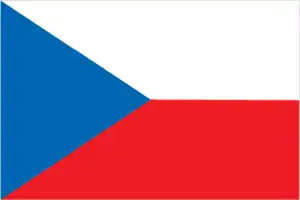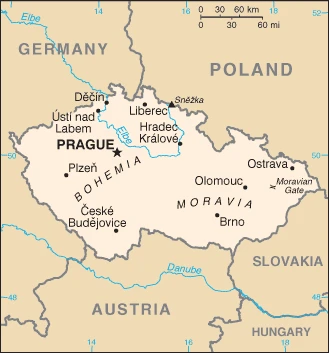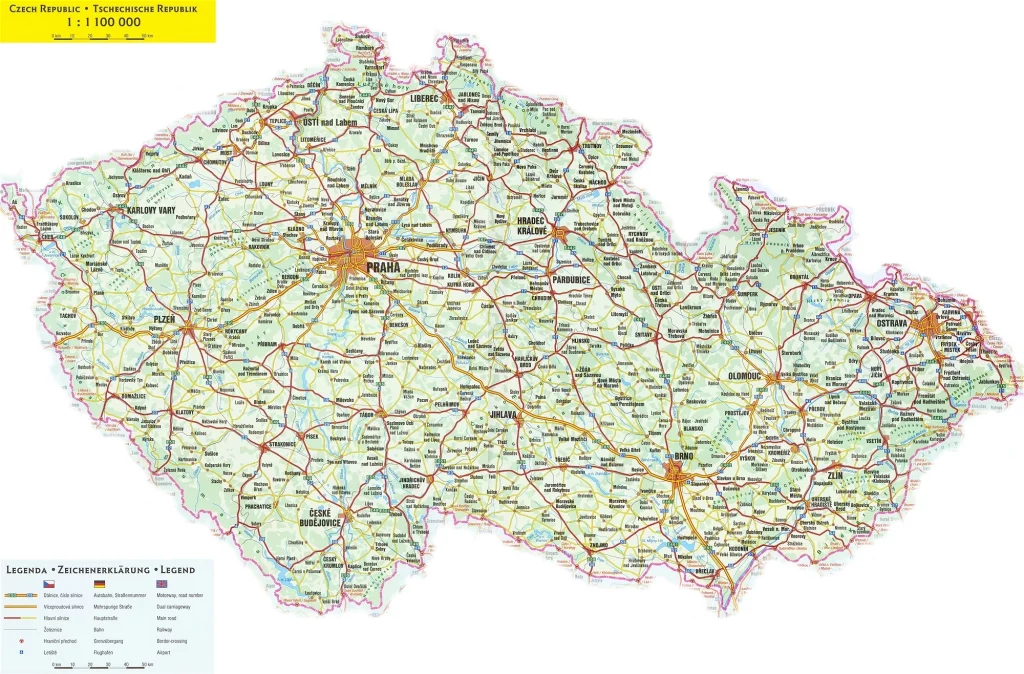Czechia Google Maps is a site/tool that offers a wide range of map views (topographic, satellite, street view) and navigation options, with little effort on your part, yet efficiently. If you need to plan a trip to a new place like Czechia, Google maps are available on desktop, mobile, or tablet. This Google maps and information page is dedicated to Czechia, Europe (47 countries), showing its location, country facts, details about its capital city Prague, bordering countries like Austria, Germany, Poland, Slovakia, and plenty of other information which may be interesting when you visit this European state.
Quick links: Google maps Czechia, Prague Google maps, Driving Directions Czechia, Printable Road Map.

About Czechia in a nutshell
- Conventional short form of the name: Czechia
- The conventional long form of the name: Czech Republic
- Local long form: Ceska republika
- Local short form: Cesko
- Former name(s): N/A
- Etymology: name derives from the Czechs, a West Slavic tribe who rose to prominence in the late 9th century A.D.; the country officially adopted the English short-form name of Czechia on 1 July 2016.
- The legal system in Czechia: a new civil code was enacted in 2014, replacing the civil code of 1964 – based on former Austro-Hungarian civil codes and socialist theory – and reintroducing former Czech legal terminology.
- Climate: Cool, sometimes cold winters and warm summer months bring most of the annual rainfall.
- The national symbols are silver (or white), double-tailed, rampant lion; national colors: white, red, and blue.
- Internet TLD: .cz
The Czech Republic was one of the satellite countries to become separated from the Soviet Union. It is an excellent place to explore what used to be the other side of the Iron Curtain. Prague is one of the most beautiful cities in Europe. While Czechoslovakia has a long history, it is a very progressive country. Fifteen years after 1989’s bloodless “Velvet Revolution” and 10 years since splitting with Slovakia, the Czech Republic finished making a list for admission into the European Union.
The heart of Bohemia is a cluttered architecture that has seen centuries of change. Gothic sits alongside Baroque, Renaissance adjoins Cubism, to mention some examples. On the hills and plains in front of the River Vltava, you will see triumphs and tragedies of the past 10 centuries with characteristic post-Communist construction present. Prague is just one of the many reasons people visit the Czech Republic. Visitors also go to west Bohemia as it boasts world-renowned spas and castles.
The ancient land of the Czech Republic is framed by the Ore Mountains, the old Sudetes up to 1,600 meters high, including the Czech Forest and the Giant Mountains, famous for their ski terrain, and the young chain of the Western Carpathians. Medieval castles and fairy-tale castles in Bohemia and the former Moravia, which encompasses the Czech basin with its tributaries of the Elbe, and charming spa towns at the foot of the Ore Mountains, perched on the thermal springs, attract visitors looking for a rest, a beer or a Becherovka. Traditional pubs are part of Prague’s Old Town image and atmosphere as Charles Bridge or the Street of the Golden Craftsmen. The vineyards that cover the southern slopes of the Moravian Basin are a great way to discover the world-famous Moravian wine.
The Czech Republic boasts 12 UNESCO World Heritage Sites: the Gothic Old Town of Prague, Cesky Krumlov, Tele, and the medieval town centers of Kutná Hora are real jewels of history, while the Renaissance palace and fortress churches of Litomysl are remarkably well-preserved examples of medieval fortress towns. The churches of Zelená Hora, Olomouc, and Trebíc in Moravia are monuments to medieval church history, while the Tugendath villa in Brno reminds modern architecture from the 1920s. In Holasovice, in southern Bohemia, the exceptionally well-preserved 200-year-old peasant Baroque houses are a rich heritage of vernacular architecture. The castles and cultural sites of Lednice, Valtice, and Kroméríz in Moravia also preserve centuries-old heritage for posterity.
Charles University in Prague was founded in the 13th century.
Background
At the close of World War I, the Czechs and Slovaks of the former Austro-Hungarian Empire merged to form Czechoslovakia. During the interwar years, having rejected a federal system, the new country’s predominantly Czech leaders were frequently preoccupied with meeting the increasingly strident demands of other ethnic minorities within the republic, most notably the Slovaks, the Sudeten Germans, and the Ruthenians (Ukrainians). On the eve of World War II, Nazi Germany occupied the territory of Czechia today, and Slovakia became an independent state allied with Germany. After the war, a reunited but truncated Czechoslovakia (less Ruthenia) fell within the Soviet sphere of influence. In 1968, an invasion by Warsaw Pact troops ended the efforts of the country’s leaders to liberalize communist rule and create socialism with a human face, ushering in a period of repression known as normalization.
The peaceful Velvet Revolution swept the Communist Party from power at the end of 1989 and inaugurated a return to democratic rule and a market economy. On 1 January 1993, the country underwent a nonviolent velvet divorce into its two national components, the Czech Republic and Slovakia. The Czech Republic joined NATO in 1999 and the European Union in 2004. The country added the short-form name Czechia in 2016 while using the full-form name, Czech Republic.
Geography
Landlocked in central Europe. Bohemia, the western territory, is a plateau surrounded by mountains. Moravia, in the east, is characterized by hills and lowlands.

Once part of Czechoslovakia, a central European communist state from 1948 – to 1989, the Czech Republic peacefully dissolved its union with Slovakia in 1993, and it joined the EU in 2004.
This state is located in Central Europe, between Germany, Poland, Slovakia, and Austria, under the coordinates of 49 45 N, 15 30 E, covering an area of 78,867 sq km with a coastline of 0 km (landlocked country). Czechia is About two-thirds the size of Pennsylvania, slightly smaller than South Carolina.
Czechia has 2,046 km of land boundaries in total and borders (4 nations): Austria 402 km, Germany 704 km, Poland 699 km, Slovakia 241 km.
Bohemia in the west consists of rolling plains, hills, and plateaus surrounded by low mountains, Moravia in the east consists of very hilly country, with Snezka 1,602 m as the highest point of Czechia, while Labe (Elbe) River 115 m as the lowest point, causing a mean elevation at 433 m throughout the country. With a total of 78,867 sq km, Czechia has 77,247 sq km of land and 1,620 sq km of water surface area.
The principal rivers are the Danube (shared with Germany, Austria, Slovakia, Hungary, Croatia, Serbia, Bulgaria, Ukraine, Moldova, and Romania) – 2,888 km, Elbe river source (shared with Germany) – 1,252 km. The significant watersheds for Czechia are Atlantic Ocean drainage: (Black Sea) Danube (795,656 sq km).
Landlocked; strategically located astride some of the oldest and most significant land routes in Europe; Moravian Gate is a traditional military corridor between the North European Plain and the Danube in central Europe.
The climate in Czechia is as follows: Temperate, cool summers, cold, cloudy, humid winters.
When you visit Czechia, the natural hazards shall be considered: Flooding.
The following major health-threatening issues shall be considered when visiting Czechia: none.
Current environmental issues affecting the Czech people: air and water pollution in northwest Bohemia and northern Moravia around Ostrava present health risks; acid rain damaging forests; land pollution caused by industry, mining, and agriculture.
Google maps Czechia
The capital and other divisions
Capital city: Prague found under the coordinates 50 05 N, 14 28 E, applying the time zone UTC+1 (6 hours ahead of Washington, DC, during Standard Time), using the following daylight saving time: +1hr begins last Sunday in March; ends last Sunday in October.
Prague is a city in the Czech Republic that offers its visitors an old-world charm with a modern twist. Prague, home to the famous Charles Bridge, may seem like it’s been here forever, but it has only been around for four centuries. Prague is often referred to as Europe’s most romantic destination.
Czechia became independent on 1 January 1993 (Czechoslovakia split into the Czech Republic and Slovakia);, and its national holiday is Czechoslovak Founding Day, 28 October (1918).
Administrative divisions: 13 regions (kraje, singular – kraj) and 1 capital city (hlavni mesto); Jihocesky (South Bohemia), Jihomoravsky (South Moravia), Karlovarsky (Karlovy Vary), Kralovehradecky (Hradec Kralove), Liberecky (Liberec), Moravskoslezsky (Moravia-Silesia), Olomoucky (Olomouc), Pardubicky (Pardubice), Plzensky (Pilsen), Praha (Prague), Stredocesky (Central Bohemia), Ustecky (Usti), Vysocina (Highlands), Zlinsky (Zlin).
People and society
Secular and urban society, with high divorce rates. Czechs make up the vast majority of the population, while the next largest group are Moravians. The 300,000 Slovaks left after the partition are now permitted dual citizenship. Ethnic tensions are few, but there is widespread hostility toward the Roma minority. A new commercial elite is emerging alongside postcommunist entrepreneurs.
The population in Czechia is 10,702,596 (July 2021 estimate), with an average of 0.04% (2021 estimate) change. That means Czechia is No. 86 in the world’s populated rank list. With an average of 43.3 years median age (42 years for males and 42 years for women), Czechia ranks No. 28 on the globe’s median age rank list.
The people living in this country are the Czech(s) (noun) or Czech (adjective) and belong mainly to the following ethnic groups: Czech 64.3%, Moravian 5%, Slovak 1.4%, other 1.8%, unspecified 27.5% (2011 estimate).
They speak Czech (official language) 95.4%, Slovak 1.6%, other 3% (2011 estimate) languages and practice the following religions: Roman Catholic 10.4%, Protestant (includes Czech Brethren and Hussite) 1.1%, other and unspecified 54%, none 34.5% (2011 estimate).
We can conclude the following about the population in Czechia: A fairly even distribution throughout most of the country, but the northern and eastern regions tend to have more significant urban concentrations. In Czechia, we are talking about 74.2% (2021) of the total population living in cities, and most of them reside in the following municipalities: 1.312 million, Prague (capital city) (2021).
Industry
Traditional heavy industries (machinery, iron, car-making) have been successfully privatized. Prague attracts tourists. Skilled workforce. Will join euro in 2017 at the earliest.
Czechia is a prosperous market economy with one of the highest GDP growth rates and lowest unemployment levels in the EU. Still, its dependence on exports makes economic growth vulnerable to contractions in external demand. Czechia’s exports comprise some 80% of GDP and primarily consist of automobiles, the country’s single largest industry. Czechia acceded to the EU in 2004 but has yet to join the eurozone. While the flexible koruna helps Czechia weather external shocks, it was one of the world’s strongest performing currencies in 2017, appreciating approximately 16% relative to the US dollar after the central bank (Czech National Bank – CNB) ended its cap on the currency’s value in early April 2017, which it had maintained since November 2013. The CNB hiked in August and November 2017 – the first-rate changes in nine years – to address rising inflationary pressures of strong economic growth and a tight labor market. Since coming to power in 2014, the new government has undertaken some reforms to reduce corruption, attract investment, and improve social welfare programs, which could help increase the government’s revenues and improve the living conditions for Czechs.
The government introduced in December 2016 an online tax reporting system intended to reduce tax evasion and increase revenues. The government also plans to remove labor market rigidities to improve the business climate, bring procurement procedures with EU best practices, and boost wages. The country’s low unemployment rate has led to steady increases in salaries, and the government is facing pressure from businesses to allow more remarkable migration of qualified workers, at least from Ukraine and neighboring Central European countries., Long-term challenges include a rapidly aging population, a shortage of skilled workers, a lagging education system, funding an unsustainable pension and health care system, and diversifying away from manufacturing and toward a more high-tech, services-based, knowledge economy.
Czechia is rich in the following natural resources: Hard coal, soft coal, kaolin, clay, graphite, timber, and arable land.
The main industrial sectors are typically motor vehicles, metallurgy, machinery and equipment, glass, and armaments.
The country’s export sectors are robust in cars and vehicle parts, computers, broadcasting equipment, office machinery/parts, and seating (2019), partnering with these nations: Germany 31%, Slovakia 7%, Poland 6%, France 5% (2019). The export trade resulted in $174.92 billion. Note: Data are in current year dollars (2020 estimate). In a global rank of the export, values resulted in Czechia’s position of 34.
Land use in Czechia: 34.4% (2018 estimate) forest, 10.8% (2018 estimate) other.
The arable land area is 41% (2018 estimate), and the agricultural land is 54.8% (2018 estimate). Land use for permanent crops 1% (2018 estimate), permanent pasture 12.8% (2018 estimate). The sum of the area of the irrigated land is 320 sq km (2012).
The main agro-industrial products of Czechia are wheat, sugar beet, milk, barley, rapeseed, potatoes, maize, pork, triticale, and poultry.
The country typically needs to import: broadcasting equipment, cars and vehicle parts, office machinery/parts, computers, and packaged medicines (2019), partnering with the following nations: Germany 27%, China 12%, Poland 9%, Slovakia 5% (2019) in a sum value of $157.95 billion. Note: data are in current year dollars (2020 estimate) $171.43 billion. Note: data are in current year dollars (2019 estimate) $176.78 billion. Note: data are in current year dollars (2018 estimate). This sum value on the global ranking list of imports resulted in Czechia 34.
Czechia Driving Directions
In this post, you learned about Czechia, Central Europe, Germany, Poland, Slovakia, and Austria. We published some basic information about its capital Prague, and the Czech nation.
Are you interested in visiting Czechia and looking for driving directions? Click here to plan your route, or see a printable road map of Czechia below to overview the route network.
Printable map of Czechia
Did you know about Czechia?
Czechia became independent after World War II, with 90% of the country’s territory coming from what used to be Austria-Hungary.
It is one of the most industrialized countries in the world. According to recent surveys, its people are one of the happiest in the world. Czechia is also known for its rich cultural heritage, including authors, artists, musicians, and scientists.
After virtually visiting Czechia, you may also be interested in the neighboring countries: Austria, Germany, Poland, and Slovakia.
If you liked our Google map and Czechia information page,
please share it with others or save the link https://www.drivingdirections.net in your bookmarks.

